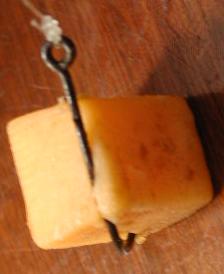| 07-07-03
"Say: CHEESE, please!"
No! Not when the photographer is preparing to take your picture. I
am thinking in terms of when you are getting the bait together for a channel
cat fishing trip.
Not just any cheese, either. It needs to be some of that good old Longhorn
that comes in the large, round rolls with the little air spaces scattered
throughout. It's the kind your mother or grandmother used to use in her
macaroni and cheese. Strong stuff.
That is the catfish-bait doctrine of the late Roscoe "Rocky" Haulk,
my fishing mentor of the long ago.
I learned it the easy way. Rocky and I were planning a fishing trip
to White River's East Fork near Brownstown. So the night before our trip
we sat in Rocky's kitchen thinking about bait.
We would, of course, seine some chubs (minnows) the next morning, and
we would get the high-dives (big yellow grasshoppers) at some weed patch
before we had seined the chubs. There would be night crawlers, too, and
catalpa worms . . . if we could find an infested tree.
"We'll need cheese squares," Rocky said, "but we can fix them right
now."
With that, Rocky went to the cupboard and brought back a white, grocery-paper
package tied neatly with some white grocer's twine, tied neatly with a
little bow. Rock opened the package and we got a good whiff of the oily
cheese. It must have been a good inch thick.
He plopped the round of cheese on a cutting board and made it square
with a butcher knife. The square was then cut in half and Rock made strips
of one half that were half an inch wide. The strips were then cut in half
to create strips that were about half an inch square, and these strips
were cut into lengths of about three-fourths (3/4) of an inch.
Rock placed these cheese quadrangles in a clean quart fruit-canning
jar and screwed on the lid. Then he put the jar (top up) in a saucepan
of steaming water.
Standing at the stove slowly rotating the jar by moving the cap between
thumb and fingers, Rock explained this heat treatment was necessary to
close those little air pockets in the cheese, make the cheese more dense
and tough, and put an oily film on the surfaces of each square.
He further explained that the heat should not be applied long enough
to cause the cubes to melt together.
Before this happened, he removed the cubes from the jar, placed them
separately on a couple of pie pans and put them in the ice box.
I must admit that I did not put great stock in this cheesy operation,
but my thinking on the value of cheese cubes as bait for channel cats took
a decided turn the next day when a four-poundish forktail threatened to
turn my split-bamboo fly rod into toothpicks before we managed to get it
in the boat.
I don't remember how many of those White River forktails we put in
the boat that afternoon and evening, but Rock's cheese cubes accounted
for almost all of our fish, although our other baits were tested.
 As
Rock taught me that day, hook size is important when fishing cheese cubes.
The hook, he said should be sturdy (he liked steel) and he wanted it to
have a gap (distance between point and shank) about the size of the cube
(in this case about half an inch). He also wanted the hook's shank to be
only slightly longer than the length of the cube. As
Rock taught me that day, hook size is important when fishing cheese cubes.
The hook, he said should be sturdy (he liked steel) and he wanted it to
have a gap (distance between point and shank) about the size of the cube
(in this case about half an inch). He also wanted the hook's shank to be
only slightly longer than the length of the cube.
Uniform-sized cubes eliminate the need to change hooks.
To bait the cubes, Rock slowly pushed the point of the hook into one
corner (toward the opposite corner on the far end). This hid the point
of the hook completely, and nestled the body of the cube at an angle against
the shank of the hook.
Even treated in this manner, cheese cubes do not have the staying power
of some other cheese and dough baits, but if cast with care it will produce
channel cat action when other baits fail. |

